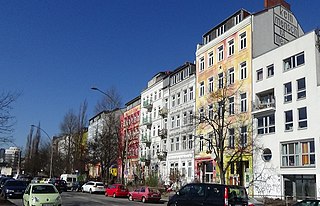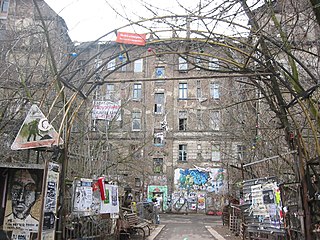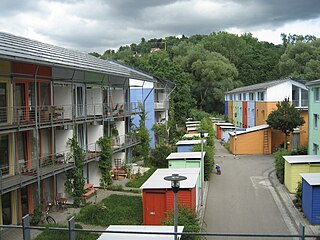 W
WAu is the name of a building that has been squatted since 1983 in Rödelheim in Frankfurt, Germany. It bills itself as a 'self-organised cultural Centre and living project'.
 W
WThe Columbushaus was a nine-storey modernist office and shopping building in Potsdamer Platz in Berlin, designed by Erich Mendelsohn and completed in 1932. It was an icon of progressive architecture which passed relatively unscathed through World War II but was gutted by fire in the June 1953 uprising in East Germany. The ruin was subsequently razed in 1957 because it stood in the border strip; the site where the structure once stood was occupied by activists shortly before the fall of the Berlin wall.
 W
WHafenstraße is a common German abbreviation of St. Pauli-Hafenstraße, a street in St. Pauli, a quarter of Hamburg, Germany.
 W
WHambach Forest is an ancient forest located near Buir in North Rhine-Westphalia, western Germany, between Cologne and Aachen. It was planned to be cleared as part of the Hambach surface mine by owner RWE AG. There were protests and occupations from 2012 against this, and in 2020 a law was passed to preserve it.
 W
WKiefernstraße is a street in the Flingern-Süd district of Düsseldorf that became notorious in the 1980s for squatting. In the mid-1980s there were connections to the Baader–Meinhof Gang. Nowadays, the former squatters have regular leases.
 W
WKøpi is a housing project located at 137 Köpenicker Straße in Mitte, Berlin. It was squatted in 1990 and legalised in 1991 as an autonomous housing project and self-managed social centre. The yard was used as a wagenplatz for people living in vehicles. It is a left-wing project, connected to punks, anarchists and Autonomen. The building has become a symbol for the radical left in Berlin in the same manner as Rozbrat in Poznań or Ungdomshuset in Copenhagen. It has survived several eviction attempts both through political pressure and because the developers have always run out of money.
 W
WLiebigstrasse 34, known as Liebig 34, was an anarchist squat in the Friedrichshain-Kreuzberg district of Berlin.
 W
WThe Rote Flora is a former theatre in the Sternschanze quarter in Hamburg. It has been squatted since November 1989 as an autonomous cultural centre in opposition to a decision to turn it into a musical theatre. The collective said in 2001 "We are the 'UFO in the neighbourhood.' The black hole in public space. The City won't get rid of us because we are a part of what life is."
 W
WRunway 18 West is a 4000 meter long runway at Frankfurt Airport, which is located in its western part and runs from north to south. The smaller northern part is located in the Frankfurt district of Flughafen,the larger southern part on the district Rüsselsheim am Main. Before the runway went into operation in 1984, the plans met with considerable protest and became one of the most important points of reference for the German environmental movement of the 1970s and 1980s.
 W
WThe Kunsthaus Tacheles was an art center in Berlin, Germany, a large building and sculpture park on Oranienburger Straße, in the sub-neighborhood of Spandauer Vorstadt in the Mitte district. Huge, colorful graffiti-style murals were painted on the exterior walls, and modern art sculptures were featured inside. The building housed an artists collective from 1990 until 2012.
 W
WThe Tommy Weisbecker Haus is a housing co-operative and self-managed social centre based in an apartment block in Kreuzberg, Berlin, Germany. It was established in 1973 when young people squatted it as an autonomous youth homeless shelter. Quickly legalized, it became a housing project and signed a new 30 year lease in 2013.
 W
WVauban is a neighbourhood (Stadtteil) to the south of the town centre in Freiburg, Germany. It was built as "a sustainable model district" on the site of a former French military base named after Sébastien Le Prestre de Vauban, the 17th century French Marshal who built fortifications in Freiburg while the region was under French rule. Construction began in 1998, and the first two residents arrived in 2001.